

Jan Maurits Quinkhard (28 January 1688 – 11 November 1772) was an 18th-century painter and print designer from the Dutch Republic.


Jan Maurits Quinkhard (28 January 1688 – 11 November 1772) was an 18th-century painter and print designer from the Dutch Republic.
Quinkhard was born in the town of Rees, near Cleves. He was a Dutch painter and scholar of his father, the painter Julius Quinkhardt the Elder, Arnold van Boonen, Christoffel Lubinietski, and Nikolaas Verkolje.
He painted familiar, allegorical, and mythological subjects, and was excellent in portraits, of which he painted a great number. Five good examples are in the Amsterdam Museum. [1]
His son Julius (1736–1776) was instructed by his father, but abandoned art for commerce. Two pictures by him are in the Amsterdam Museum. He also collaborated with Jacobus Houbraken and other leading engravers on prints of the rich and famous of Amsterdam. [2] [3]
His pupils were:
He died, aged 84, in Amsterdam.[ citation needed ]
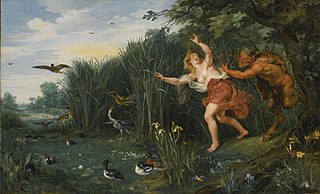
Jan Brueghelthe Younger was a Flemish Baroque painter. He was the son of Jan Brueghel the Elder, and grandson of Pieter Bruegel the Elder, both prominent painters who contributed respectively to the development of Renaissance and Baroque painting in the Habsburg Netherlands. Taking over his father's workshop at an early age, he largely painted the same subjects as his father in a style which was similar to that of his father. He gradually was able to break away from his father's style by developing a broader, more painterly, and less structured manner of painting. He regularly collaborated with leading Flemish painters of his time.

Nicolaes Pieterszoon Berchem was a highly esteemed and prolific Dutch Golden Age painter of pastoral landscapes, populated with mythological or biblical figures, but also of a number of allegories and genre pieces.
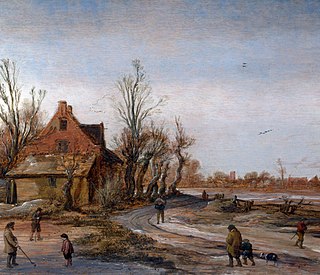
Esaias van de Velde was a Dutch landscape painter.
Events from the year 1772 in art.

Jacob de Gheyn II was a Dutch painter and engraver, whose work shows the transition from Northern Mannerism to Dutch realism over the course of his career.

Adriaen van Nieulandt was a Dutch painter, draughtsman and engraver of Flemish descent. He is known for his history paintings with biblical and mythological subjects, often incorporating elegant nudes, portraits including schutterstukken, genre paintings and still lifes.

Cornelis Anthonisz., Anthonisz. also spelled Anthonissen or Teunissen, was a Dutch painter, engraver, and mapmaker.

Jurriaan Andriessen was a Dutch decorative painter and graphic artist.

Jan de Beijer, also given as Jan de Beyer, was a Dutch draughtsman and painter known for this drawings of towns and buildings in the present-day countries of the Netherlands, Belgium and Germany. In total, he produced some 1500 drawings, over 600 of which were reproduced as engravings by other artists.

Hendrick van Anthonissen was a Dutch marine painter.
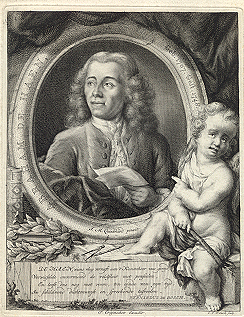
Abraham de Haen, also known as Abraham de Haan, was a Dutch draughtsman and engraver known particularly for his drawings of castles and manors. He was also a painter and poet.

Arnold van Boonen was a Dutch portrait painter.

Justus van Huysum, also spelled Huijsum, was a Dutch Golden Age painter.
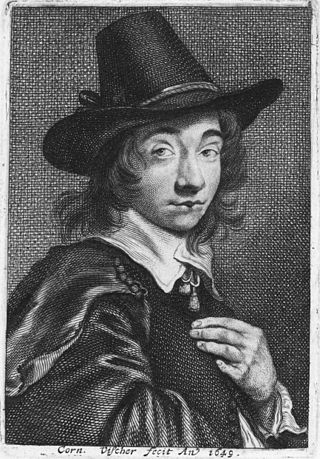
Cornelis Visscher, was a Dutch Golden Age engraver and the brother of Jan de Visscher and Lambert Visscher.

Louis Bernard Coclers was a Southern Netherlandish portrait painter and engraver who worked mainly in Liège, Maastricht, Leiden and Amsterdam.

Michael Vandergucht (née Michiel van der Gucht; c. 1660 – 16 October 1725) was a Flemish engraver and painter who worked for most of his career in England. He engraved portraits, book illustrations, and architectural prints and painted portraits.

Adriaan de Lelie was a Dutch painter.
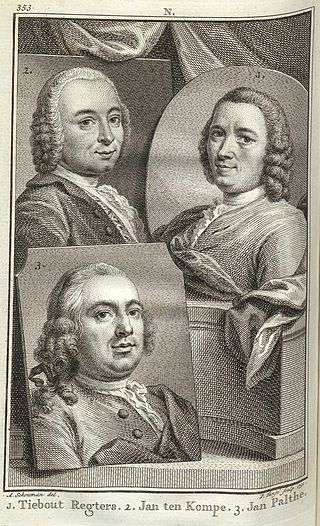
Tibout Regters was an 18th-century portrait painter from the Dutch Republic.
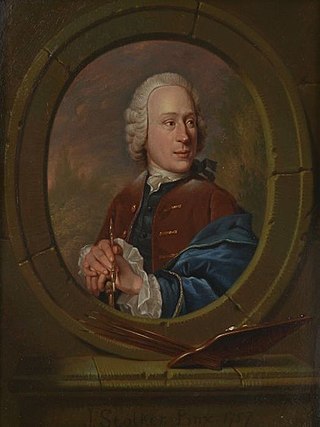
Jan Stolker was a Dutch printmaker, painter, painting dealer, and art collector.

The Stadstekenacademie was an 18th-century art academy in Amsterdam. It was the precursor of the Koninklijke Academie and the Rijksakademie van beeldende kunsten. Other Dutch towns such as Haarlem also had a drawing academy.
Attribution:
![]() Media related to Jan Maurits Quinkhard at Wikimedia Commons
Media related to Jan Maurits Quinkhard at Wikimedia Commons